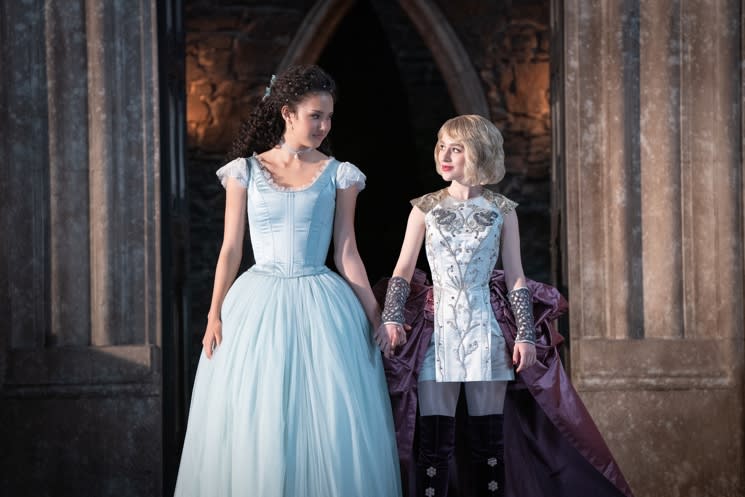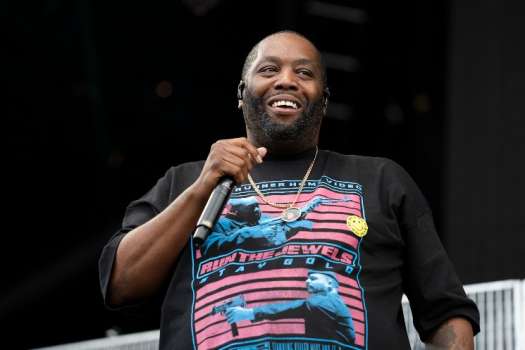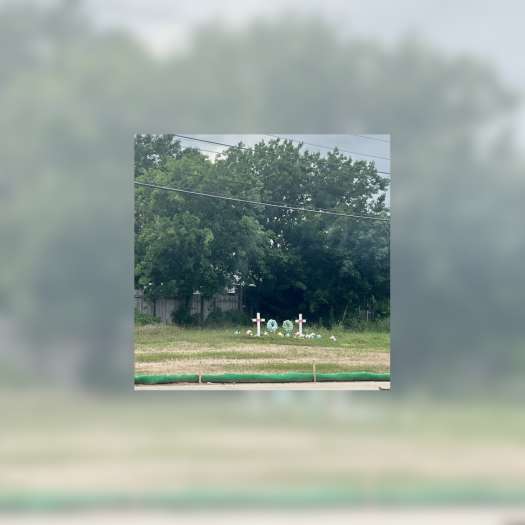Good versus evil — the classic moral binary underlying centuries of storytelling. It's a tried and true formula, repeated countless times in fairytales and folklore: the sweet, beautiful, righteous heroes facing off against cruel, ugly, sinister villains. But is it really ever that simple? The Netflix film The School for Good and Evil argues no, people are much too nuanced to fit into such neat categories. There is no one truly "good" and, likewise, no one who is pure "evil." At least, this is what the film tries to argue.
Directed and co-written by Paul Feig, The School for Good and Evil is the latest young-adult fantasy film centring on a magical boarding school. Beautiful peasant girl Sophie (Sophia Anne Caruso) believes she is destined for greater things in life, while her "ugly" (i.e. less overtly feminine) friend Agatha (Sofia Wylie) just wants to live a simple life, taking care of her sick mother. Despite being polar opposites, the two are bosom pals — so when Sophie attempts to escape her mundane existence by heading for the titular School for Good and Evil, Agatha follows to stop her and they both end up as pupils.
In a twist neither saw coming (but the audience certainly did), Sophie is placed with the "ugly" students in the evil school, while Agatha is dropped off with the wannabe princesses in the good school. Both must navigate the fantastical school while also grappling with roles that seem contrary to their nature.
The film features a strong cast. In addition to Disney alum Wylie as Agatha and relative newcomer Caruso in the role of Sophie, The School for Good and Evil includes a number of stars: Laurence Fishburne as the School Master, Charlize Theron as Lady Leonora Lesso and Michelle Yeoh as Professor Emma Anemone, just to name a few. Unfortunately, none of the veteran actors are given much to do here, but they're all charming enough to carry their scenes.
The School for Good and Evil is, in many ways, the typical post-2000 teeny bopper flick: a romantic, coming-of-age story about an unlikely protagonist (in this case, Agatha) who "isn't like the other girls." To its credit, The School for Good and Evil makes attempts to subvert genre tropes. The story's main conflict destabilizes the established binary between good and evil, poking fun at traditional gender roles in the process.
The film drags along at its 147-minute runtime, putting it in league with the infamously long-running Harry Potter films; The School for Good and Evil is far less memorable, however. The story is essentially a straightforward fairytale narrative, complicated slightly by the school setting. There is not nearly enough content to justify the two-and-a-half hour length. Its closest comparison, Disney Channel's Descendants, tells a very similar story in just 112 minutes — and it features musical numbers! By the second hour of The School for Good and Evil, the film starts to feel like a never-ending story, which zaps what little fun it had going for it. (The actual NeverEnding Story is a tight 94 minutes long.)
To be blunt, The School for Good and Evil suffers from too much testosterone behind the camera. For a film about teenage girls aimed at a female audience, there aren't a lot of women making creative decisions, and it shows. The film's writers, director, editor and cinematographer are all men, and this may be why so many of the scenes fall flat. Agatha and Sophie have little depth, and the film's attitude towards female vanity, specifically, reeks of sexism.
The audience is expected to admire Agatha because she is so unlike her peers: she prefers pants over dresses, doesn't "smile" on command, and is bold and brave. But in praising Agatha for being different, there's an implicit message that wanting to be a pretty princess is inherently bad, and is that not in itself a condemnation of traditional femininity? Rather than a story about sisterhood and being true to oneself, The School for Good and Evil ends up promoting many of the values it claims to denounce.
This isn't to say Feig isn't capable of delivering a female-centred story. His 2018 dark comedy A Simple Favor was surprisingly fresh and funny. A notable difference, however, is that the film was written by a woman (Jessica Sharzer) and Feig co-produced with a woman (Jessie Henderson). The School for Good and Evil desperately needs that kind of perspective, because it feels like exactly what it is: a story about teen girls written by 60-year-old men.
(Netflix)Directed and co-written by Paul Feig, The School for Good and Evil is the latest young-adult fantasy film centring on a magical boarding school. Beautiful peasant girl Sophie (Sophia Anne Caruso) believes she is destined for greater things in life, while her "ugly" (i.e. less overtly feminine) friend Agatha (Sofia Wylie) just wants to live a simple life, taking care of her sick mother. Despite being polar opposites, the two are bosom pals — so when Sophie attempts to escape her mundane existence by heading for the titular School for Good and Evil, Agatha follows to stop her and they both end up as pupils.
In a twist neither saw coming (but the audience certainly did), Sophie is placed with the "ugly" students in the evil school, while Agatha is dropped off with the wannabe princesses in the good school. Both must navigate the fantastical school while also grappling with roles that seem contrary to their nature.
The film features a strong cast. In addition to Disney alum Wylie as Agatha and relative newcomer Caruso in the role of Sophie, The School for Good and Evil includes a number of stars: Laurence Fishburne as the School Master, Charlize Theron as Lady Leonora Lesso and Michelle Yeoh as Professor Emma Anemone, just to name a few. Unfortunately, none of the veteran actors are given much to do here, but they're all charming enough to carry their scenes.
The School for Good and Evil is, in many ways, the typical post-2000 teeny bopper flick: a romantic, coming-of-age story about an unlikely protagonist (in this case, Agatha) who "isn't like the other girls." To its credit, The School for Good and Evil makes attempts to subvert genre tropes. The story's main conflict destabilizes the established binary between good and evil, poking fun at traditional gender roles in the process.
The film drags along at its 147-minute runtime, putting it in league with the infamously long-running Harry Potter films; The School for Good and Evil is far less memorable, however. The story is essentially a straightforward fairytale narrative, complicated slightly by the school setting. There is not nearly enough content to justify the two-and-a-half hour length. Its closest comparison, Disney Channel's Descendants, tells a very similar story in just 112 minutes — and it features musical numbers! By the second hour of The School for Good and Evil, the film starts to feel like a never-ending story, which zaps what little fun it had going for it. (The actual NeverEnding Story is a tight 94 minutes long.)
To be blunt, The School for Good and Evil suffers from too much testosterone behind the camera. For a film about teenage girls aimed at a female audience, there aren't a lot of women making creative decisions, and it shows. The film's writers, director, editor and cinematographer are all men, and this may be why so many of the scenes fall flat. Agatha and Sophie have little depth, and the film's attitude towards female vanity, specifically, reeks of sexism.
The audience is expected to admire Agatha because she is so unlike her peers: she prefers pants over dresses, doesn't "smile" on command, and is bold and brave. But in praising Agatha for being different, there's an implicit message that wanting to be a pretty princess is inherently bad, and is that not in itself a condemnation of traditional femininity? Rather than a story about sisterhood and being true to oneself, The School for Good and Evil ends up promoting many of the values it claims to denounce.
This isn't to say Feig isn't capable of delivering a female-centred story. His 2018 dark comedy A Simple Favor was surprisingly fresh and funny. A notable difference, however, is that the film was written by a woman (Jessica Sharzer) and Feig co-produced with a woman (Jessie Henderson). The School for Good and Evil desperately needs that kind of perspective, because it feels like exactly what it is: a story about teen girls written by 60-year-old men.




